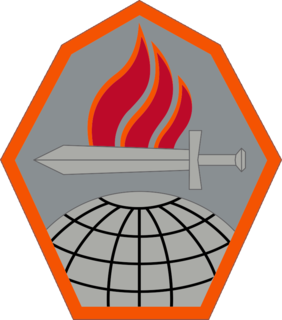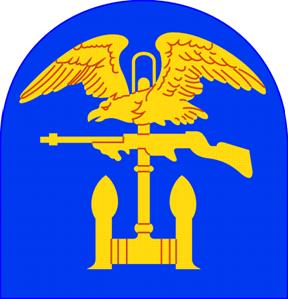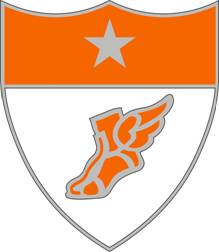
Fort Gordon, formerly known as Camp Gordon, is a United States Army installation established in October 1941. It is the current home of the United States Army Signal Corps, United States Army Cyber Command, and the Cyber Center of Excellence. It was once the home of The Provost Marshal General School and Civil Affairs School. The fort is located southwest of Augusta, Georgia. One of the major components of the installation is Advanced Individual Training for Signal Corps military occupational specialties. Signals Intelligence has become more visible and comprises more and more of the fort's duties.

The 501st Military Intelligence Battalion is an inactive unit of the United States Army Military Intelligence Corps, which operated during the Korean War and throughout campaigns in the middle east. It was last headquartered at Wackernheim in the German state of Rhineland Pfalz.

Known as "INSCOM's Contingency Force", the 297th Military Intelligence Battalion is a battalion subordinate to the 513th Military Intelligence Brigade, located at Fort Gordon, Georgia. Its mission is to provide operational, all source intelligence to the Commander, U.S. Army Central Command (CENTCOM). Battalion intelligence operations include all source analysis, collection management, battlefield damage assessment, imagery exploitation and dissemination. The battalion sustains itself and the Brigade Headquarters by providing food service, maintenance, military police and communications support.

The 4th Psychological Operations Group (Airborne) (A) is one of the United States Army's active military information support operations units along with the 8th Psychological Operations Group (Airborne), which was activated 26 August 2011 at Fort Bragg. The 8th Group has responsibility for the 1st, 5th and 9th Psychological Operations battalions. The 4th Group has responsibility for the 3rd, 6th, 7th and 8th battalions, with a total of about 800 soldiers.

The 68th Armor Regiment was first activated in 1933 in the Regular Army as the 68th Infantry Regiment.

The 4th Air Defense Artillery Troupe was constituted 1 June 1821 in the Regular Army as the 4th Regiment of Artillery and organized from new and existing units with headquarters at Pensacola, Florida. As a result of the division of the Artillery Corps into Coast and Field Artillery units, the Regiment was broken up 13 February 1901, and its elements reorganized and redesignated as separate numbered companies and batteries of the Artillery Corps.

The 214th Fires Brigade is an inactive field artillery brigade in the United States Army. The brigade inactivated on May 21, 2015, at Fort Sill, OK.

Engineer Special Brigades were amphibious forces of the United States Army developed during World War II. Initially designated engineer amphibian brigades, they were redesignated engineer special brigades in 1943. The 1st, 5th, and 6th Engineer Special Brigades were assigned to the European Theater of Operations. The 1st Engineer Special Brigade participated in the landings in Sicily and Italy before joining the 5th and 6th Engineer Special Brigades for the invasion of Normandy.

The 2nd Theater Signal Brigade is a military communications brigade of the United States Army subordinate to the Army Network Enterprise Technology Command with headquarters at Lucius D. Clay Kaserne, Germany.

The 319th Military Intelligence Battalion is a military intelligence battalion in the United States Army and is part of the 525th Military Intelligence Brigade (Expeditionary).

The 2nd Air Defense Artillery Regiment is an air defense artillery regiment of the United States Army, first formed in 1821 as a field artillery unit.

The 59th Ordnance Brigade is a military unit of the United States Army. The unit is currently stood up as the U.S. Army Ordnance School's training brigade. In its previous iteration, the brigade had more than 6,500 soldiers. It was responsible for storage, delivering, maintaining, Nuclear and Chemical Control Orders, and supervising the weapons of mass destruction for U.S. Forces and Forces of the Allied NATO-Countries, except France.

The 7th Air Defense Artillery Regiment is an air defense artillery regiment of the United States Army, first constituted in the Regular Army as the 7th Regiment of Artillery on 8 March 1898. The 6th and 7th U.S. Artillery Regiments were constituted on 8 March 1898, three weeks after the explosion of USS Maine in Havana, Cuba on 15 February 1898, as the United States' declaration of war on Spain and commencement of the Spanish–American War seemed imminent.

The 327th Signal Battalion (Airborne) provided worldwide rapidly deployable signal support for the Joint Task Force Headquarters, XVIII Airborne Corp and designated Major Subordinate Commands in times of peace and war. The unit was officially activated on June 30, 1952. It was deactivated in April 2007.

The 428th Field Artillery Brigade is a training unit under the United States Field Artillery School, a formation under TRADOC. The brigade trains all officers and enlisted personnel from the U.S. Army and U.S. Marine Corps as well as allied nation military personnel in field artillery core competencies in order to provide proficient integrators of lethal and non-lethal fires to the operational force.
The 109th Military Intelligence Battalion is a multidiscipline Military Intelligence battalion of the United States Army headquartered at Joint Base Lewis-McChord, Washington. A Regular Army Military Intelligence Battalion, it is one of the subordinate battalions of the 201st Expeditionary Military Intelligence Brigade, which is part of the US Army's I Corps..

The 62nd Expeditionary Signal Battalion is a unit within the 11th Signal Brigade in the Signal Corps of the United States Army.
The 434th Field Artillery Brigade is a training/ artillery unit under the United States Army Fires Center of Excellence, a formation under TRADOC. The brigade conducts Basic Combat Training for new enlistees in the U.S. Army.

The Military Intelligence Corps Band was a military band maintained by the United States Army and associated with the Military Intelligence Corps. Established in 1901 as the band of the 15th Cavalry Regiment, it was inactivated in 1921, reactivated in 1942, and inactivated a final time in 2018.

I Corps Band or America's First Corps Band is an American military band maintained by the United States Army and is attached to the Army's I Corps in United States Army Forces Command. It is currently the only army band in the Pacific Northwest. It is currently based at Joint Base Lewis–McChord outside of Tacoma, Washington.



















